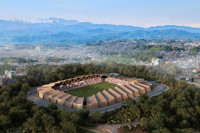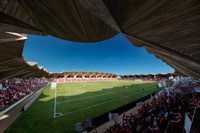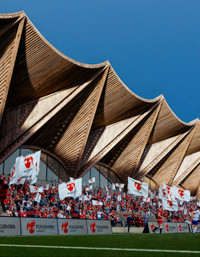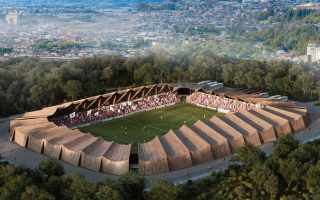Fukushima United FC Stadium
| Capacity | 5 000 |
|---|---|
| Country | Japan |
| City | Fukushima |
| Clubs | Fukushima United FC |
| Category | Design awaiting implementation |
| Cost | ? |
| Construction | ? |
| Design | VUILD, Inc. |
Advertisement
Fukushima United FC Stadium – design description
A new home for J3 League side Fukushima United FC will be built entirely of wood. While this material has a long tradition in Japanese architecture, its use as the sole construction material for a stadium today is quite unconventional.
The stadium will hold 5,000 spectators on four single-tier stands. Its most distinctive feature will be a roof composed of parabolic segments, inspired by thatched-roof houses in the historic town of Ōuchi-juku.
Behind the stands there will be service facilities, with two levels provided in the main stand. The overall height of the building will not exceed 16 meters.
The timber used for the stadium will come from Fukushima Prefecture, and local residents are expected to be actively involved in the construction. All materials are intended to be reusable or recyclable.
The idea of reusing materials is not only an expression of responsible resource management – it also refers to the themes of rebirth and reconstruction. In the Fukushima stadium concept this is expressed through three references:
- The rebuilding of the city after the 2011 disaster (earthquake, tsunami and nuclear accident), with the stadium symbolically reflecting the region’s regeneration
- The motif of the phoenix – Fukushima United FC’s crest features a phoenix, symbolizing rising from the ashes and renewal
- Reference to Shikinen Sengu – the Japanese tradition of periodically rebuilding temples, symbolizing cycles and rebirth
The stadium will follow the concept of a passive building, with the geometry of the roof and facades designed to enhance comfort: in winter it shields against cold air, while in summer it channels breezes onto the stands and limits overheating from the sun. Part of the rainwater will be collected and reused, while snow stored in winter may serve as natural cooling during summer.
The design was created by Japanese studio VUILD, Inc. in cooperation with British engineering firm Arup. The concept was first published on August 30, 2025.
Advertisement
Renderings
-

2025 © VUILD Inc. 
2025 © VUILD Inc. 
2025 © VUILD Inc. 
2025 © VUILD Inc.

 StadiumDB
StadiumDB